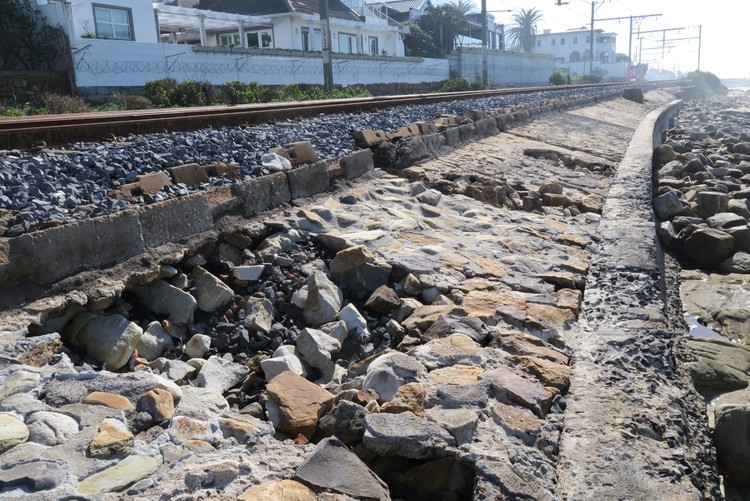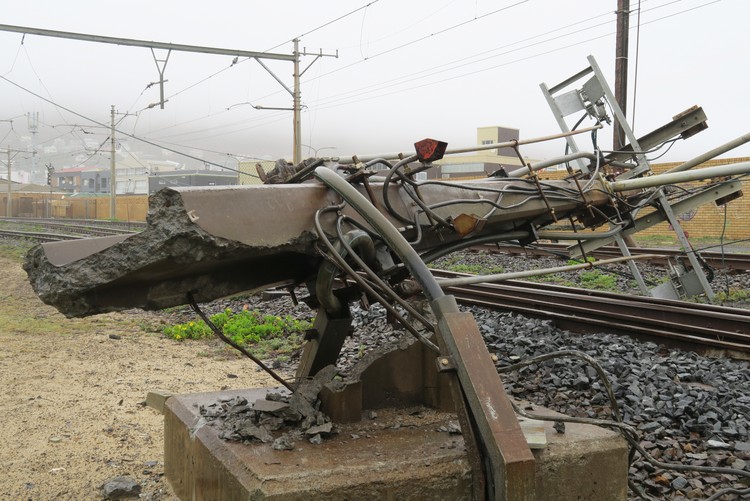Trains are running again on Metrorail’s Southern Line but the embankment needs attention
The Transport Minister is due to catch a train from Fish Hoek to Cape Town on Tuesday
The embankment between Dalebrook and St James train station is eroding, with remedial work overdue. Photos: Steve Kretzmann
The railway line between Cape Town station and Fish Hoek is working again, two weeks after serious storm damage. Transport Minister Sindisiwe Chikunga, accompanied by the PRASA Board of Control and Management, is to take a train ride from Fish Hoek to Cape Town Station on Tuesday.
A concrete mast holding the overhead transmission lines was blown over during storms on 7 April, resulting in the closure of the entire Southern Line on 8 April. The Cape Flats line also had to be closed because it branches off the Southern Line at Retreat.
The Cape Flats Line and the Southern Line between Cape Town and Retreat were reopened on 9 April, with the service from Retreat to Fish Hoek only being reinstated on 22 April.
The cause of the concrete mast breaking was “inclement weather”, said Metrorail spokesperson Zinobulali Mihi.
However, there are concerns that the line is not undergoing regular maintenance, as the embankment between Dalebrook and St James train station is eroding, with remedial work overdue.
Resident Steve Herbert told GroundUp he brought the erosion of the embankment to the attention of the Passenger Rail Agency South Africa (PRASA) “years ago”.
Herbert said PRASA sent out an engineer 10 years ago, who at that point said remedial work needed to be done urgently.
“Reminders from time to time elicited no response,” said Herbert. “There has been further deterioration. You don’t have to be an engineer to see the major damage along this strip.”
He said earlier this year PRASA had dumped tons of gravel along the tracks which helps stabilise the tracks but did nothing for the damage to the embankment.
In response, Mihi told GroundUp that Metrorail in the Western Cape was aware of the embankment erosion.
“We are currently working on a supply chain process to procure the services of a contractor that will assist us in rebuilding the bank cuttings and seawalls on the coastal side of the area,” stated Mihi.
She said the project was to take effect this year.
Meanwhile, a senior structural engineer, who asked not be named as he works for a well-known private company, said whatever caused the concrete mast to break was “not something ordinary”. He said it seemed as if it was “pulled over” and broke at the base. He said he did not want to speculate on what, along with the wind, could have caused the breakage as “these masts are very strong”.
He said an in depth investigation of the concrete, the wire reinforcement and the age of the mast would be necessary.
Asked about maintenance work, Mihi said Metrorail’s technical teams inspect the entire line every week.
“A thorough inspection was done by the whole team of engineers and engineering technicians … and we have taken inventory of exactly what is required on the entire line right up to Simon’s Town,” she said.
A concrete mast was blown over during storms on 7 April, resulting in the closure of the entire Southern Line as well as the Cape Flats Line on 8 April.
Next: Limpopo villagers force minister to turn around
Previous: Scrap electricity tariff hikes, demand Durban residents
Letters
Dear Editor
No matter how smart the train sets become, the middle class will not use them. Rondebosch station is a good example. Filth and rubbish all around, and a subway which has become unusable. Until this aspect of railway service is improved, a lot of southern suburb residents will keep away from the trains.
© 2024 GroundUp. This article is licensed under a Creative Commons Attribution-NoDerivatives 4.0 International License.
You may republish this article, so long as you credit the authors and GroundUp, and do not change the text. Please include a link back to the original article.
We put an invisible pixel in the article so that we can count traffic to republishers. All analytics tools are solely on our servers. We do not give our logs to any third party. Logs are deleted after two weeks. We do not use any IP address identifying information except to count regional traffic. We are solely interested in counting hits, not tracking users. If you republish, please do not delete the invisible pixel.




